<< Previous | Displaying results 5601-5650 of 6769 for "" | Next >>
View of the entrance to Oskar Schindler's enamel works in Zablocie, a suburb of Krakow. Poland, 1939-1944.
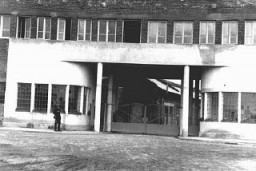
Scene from one of Oskar Schindler's parties in Krakow. At such events, Schindler (second from left) attempted to bribe Nazi officials for information about imminent deportations. Krakow, Poland, 1943.
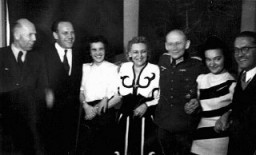
Oskar Schindler (left) at his enamel works in Zablocie, a suburb of Kraków. Poland, 1943-1944.
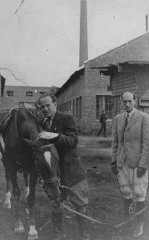
Amon Goeth, commandant of the Płaszów camp. Płaszów, Poland, between February 1943 and September 1944.
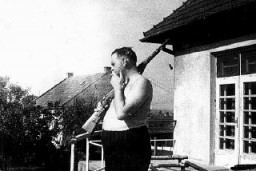
Camp commandant Amon Goeth delivers a speech to SS guards in the Płaszów camp. Płaszów, Poland, 1943-1944.

Construction of Oskar Schindler's armaments factory in Bruennlitz. Czechoslovakia, October 1944.

Construction of Oskar Schindler's armaments factory in Bruennlitz. Czechoslovakia, October 1944.
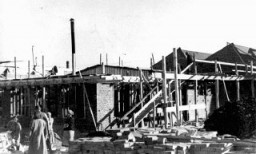
View during the construction of Oskar Schindler's armaments factory in Bruennlitz. This photograph shows the construction of a rail line to the factory. Czechoslovakia, October 1944.
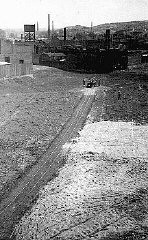
Construction of Oskar Schindler's armaments factory in Bruennlitz. Czechoslovakia, October 1944.
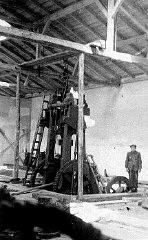
Oskar Schindler standing (second from right) with some of the people he rescued. Munich, Germany, May–June 1946.
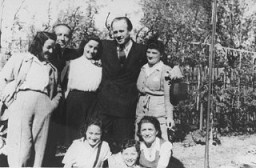
In Yad Vashem, the Israeli national institution of Holocaust commemoration, Oskar Schindler plants a tree in honor of his rescue efforts. Jerusalem, Israel, 1962.
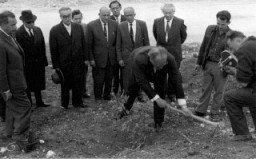
At Yad Vashem, the Israeli national institution of Holocaust commemoration, Oskar Schindler stands next to the tree planted in honor of his rescue efforts. Jerusalem, Israel, 1970.
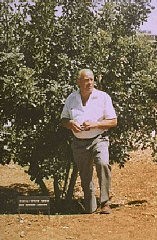
Ink and Blood by Arthur Szyk, 1944. Szyk portrayed himself at his desk, finishing off a still-struggling Adolf Hitler. Göring, Himmler, and Franco attempt to escape. In the wastebasket are the defeated figures of Mussolini, Laval, and Petain, whose regimes fell as a result of the Allied invasions. [Gift of Alexandra and Joseph Braciejowski]
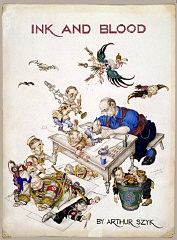
A Jewish family strolls along a street in prewar Kalisz. Poland, May 16, 1935.
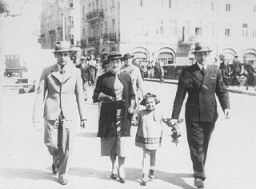
Prewar portrait of mother and son Zeni and Rudy Farbenblum. Munkacs, 1922.
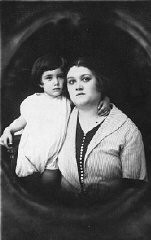
Portrait of the Ehrlich family seated around the family table. Munkacs, Czechoslovakia, 1930. Among those pictured is Elizabeth Ehrlich (later Roth) standing in the middle of the back row in a light dress, and Rella Ehrlich (front row, second from the right). Elizabeth was born in Munkacs. In 1944 she was confined to the ghetto there before being deported with her family to Auschwitz. She was later transferred to a camp in Bydogszcz, Poland, and from there to the Stutthof concentration camp.
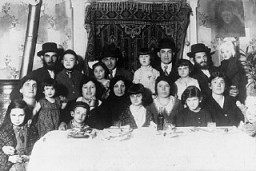
Jewish men sitting on the steps of a synagogue. Munkacs, Czechoslovakia, 1936.
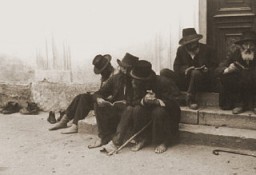
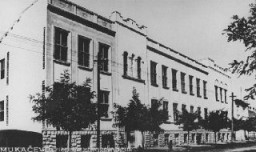
Group portrait of students and teachers at the Hebrew gymnasium in Munkacs. 1936-1937.
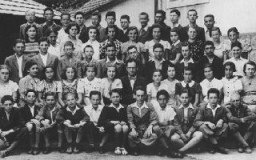
The Weinberger children pose for a photograph. Munkacs, 1940.
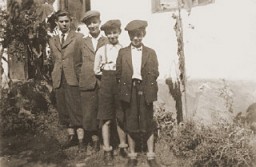
Group portrait of members of the Katz family of Munkacs. Pictured in the top row from left to right are: Chicha, Isabella, Philip, Jolon (Cipi), and Regina. In the bottom row are Helen (left) and Tereza. Munkacs, 1942–1943.
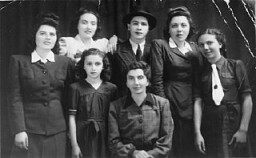
Books and writings deemed "un-German" are burned at the Opernplatz (Opera Square). Berlin, Germany, May 10, 1933.
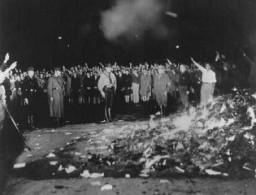
Students and members of the SA unload books deemed "un-German" during the book burning in Berlin. The banner reads: "German students march against the un-German spirit." Berlin, Germany, May 10, 1933.
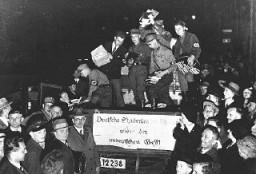
Students and members of the SA with armfuls of literature deemed "un-German" during the book burning in Berlin. Germany, May 10, 1933.
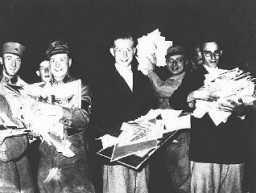
In Hamburg, members of the SA and students from the University of Hamburg burn books they regard as "un-German." Hamburg, Germany, May 15, 1933.
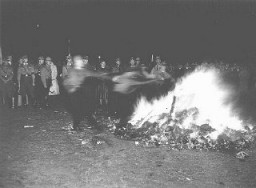
At Berlin's Opernplatz (Opera Square), an SA man throws books into the flames at the public burning of books deemed "un-German." This image is a still from a motion picture. Berlin, Germany, May 10, 1933.
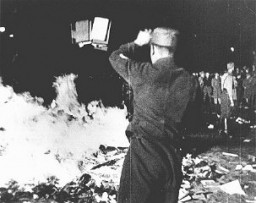
Public burning of "un-German" books in the Opernplatz (Opera Square) in Berlin. Students, some in SA uniform, march in a torchlight procession. Berlin, May 10, 1933.
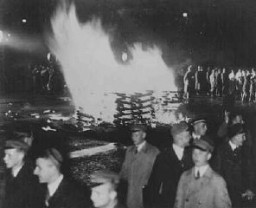
Joseph Goebbels, German propaganda minister, speaks on the night of book burning. Berlin, Germany, May 10, 1933.
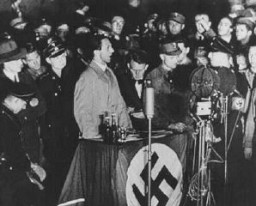
Propaganda Minister Joseph Goebbels (at podium) praises students and members of the SA for their efforts to destroy books deemed "un-German" during the book burning at Berlin's Opernplatz (opera square). Germany, May 10, 1933.

Gavra Mandil celebrates his fourth birthday with his parents, Mosa and Gabriela, and sister Irena. Novi Sad, Yugoslavia, September 6, 1940.
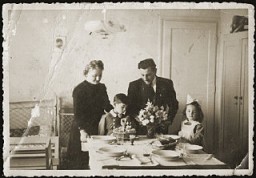
Mr. Mandil and his son Gavra, Yugoslav Jews, while in hiding. The Mandil family escaped to Albania in 1942. After the German occupation in 1943, Mandil's Albanian apprentice hid the family, all of whom survived. Albania, between 1942 and 1945.
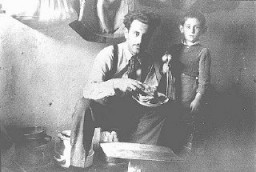
An interior view of the Sephardic synagogue on Luetzowstrasse. Berlin, Germany, before November 1938.
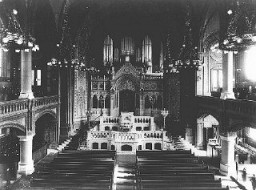
Bertolt Brecht, author of the "Threepenny Opera" and a well-known leftist poet and dramatist, who emigrated from Germany in 1933. In exile, he co-edited an anti-Nazi magazine titled Das Wort. London, Great Britain, 1936.
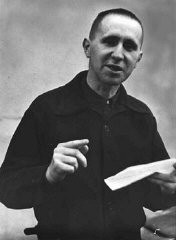
Bertolt Brecht (left), Marxist poet and dramatist, was a staunch opponent of the Nazis. He fled Germany shortly after Hitler's rise to power. Pictured here with his son, Stefan. Germany, 1931.
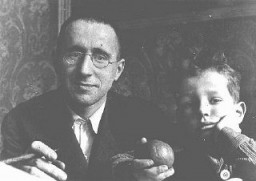
Author Lion Feuchtwanger in New York, November 17, 1932. Feuchtwanger's 1930 novel Erfolg (Success) provided a thinly veiled criticism of the Beer Hall Putsch and Hitler's rise to leadership in the Nazi Party. He was targeted by the Nazis. After the Nazi takeover on January 30, 1933, his house in Berlin was illegally searched and his library was plundered during his lecture tour in the United States.
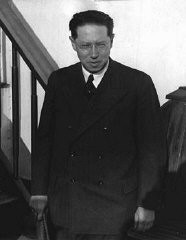
Lion Feuchtwanger aboard the ship Excalibur, arriving in New York. United States, October 1940.
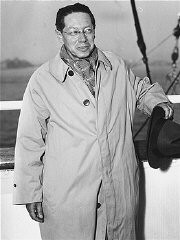
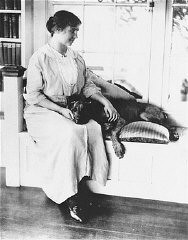
Portrait of Helen Keller, ca. 1910. In 1933, Nazi students at more than 30 German universities pillaged libraries in search of books they considered to be "un-German." Among the literary and political writings they threw into the flames were the works of Helen Keller.
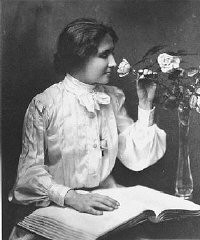
Ernest Hemingway in his World War I Red Cross Ambulance Corps uniform, ca. 1918.
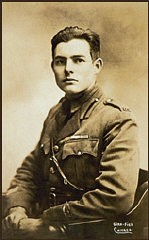
Portrait of Ernest Hemingway by Helen Pierce Breaker. Paris, France, ca. 1928. In 1933, Nazi students at more than 30 German universities pillaged libraries in search of books they considered to be "un-German." Among the literary and political writings they threw into the flames were the works of Ernest Hemingway.
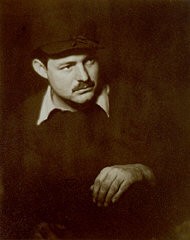
Cover of Ernest Hemingway's A Farewell to Arms. (1929 cover. Princeton University Library.) In 1933, Nazi students at more than 30 German universities pillaged libraries in search of books they considered to be "un-German." Among the literary and political writings they threw into the flames during the book burning were the works of Ernest Hemingway.
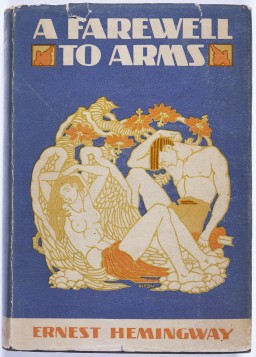
American novelist Ernest Hemingway on safari, ca. 1933. In 1933, Nazi students at more than 30 German universities pillaged libraries in search of books they considered to be "un-German." Among the literary and political writings they threw into the flames were the works of Ernest Hemingway.

Author Ernest Hemingway aboard the boat Pilar, ca. 1950. In 1933, Nazi students at more than 30 German universities pillaged libraries in search of books they considered to be "un-German." Among the literary and political writings they threw into the flames were the works of Ernest Hemingway.
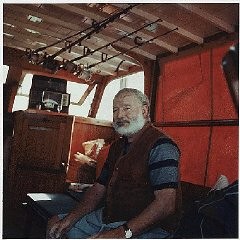
Ernest Hemingway, among the greatest American novelists, was a member of the "Lost Generation" of expatriate writers who were disillusioned by war. In 1933 the Nazis burned Hemingway's novels as part of the public book burning in Berlin. United States, ca. 1950.
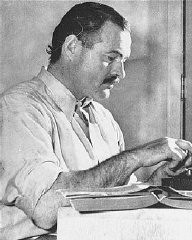
During a roundup for deportation in eastern Poland in 1942, Gitta Rosenzweig—then three or four years old—was sent into hiding. She ended up in a Catholic orphanage. In 1946, Ida Rosenshtein, a family friend and a survivor, learned of the child's whereabouts and sought to claim her. After denying that it held a Jewish child, the orphanage relinquished custody after Ida recognized Gitta and a local Jewish committee paid a "redemption" fee. Gitta is pictured here on the day she left the orphanage.
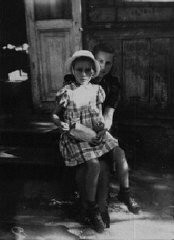
Portrait of Tsewie Herschel seated in a chair, taken while he was living in hiding. Oosterbeek, the Netherlands, 1943–1944. Tsewie never knew his parents. Born in December 1942, he was hidden with the de Jong family in April 1943. That July, his parents were deported from the Netherlands to the Sobibór killing center. The de Jongs renamed Tsewie "Henkie," raised him as a Christian, and treated him as their son. Tsewie learned about his origins from his paternal grandmother, who reclaimed him…

Portrait of three-year-old Estera Horn wrapped in a fur coat. Chelm, Poland, ca. 1940. Estera was born in January 1937. Her father was killed soon after the Germans invaded Poland. Estera and her mother, Perla Horn, were forced into the ghetto in Chelm. At the end of 1942, during the liquidation of the ghetto, Perla and Estera escaped from the ghetto. They hid in nearby villages. In late 1943, Perla asked a family in Plawnice to take care of Estera. Perla tried to hide with a group of Jews in the nearby…
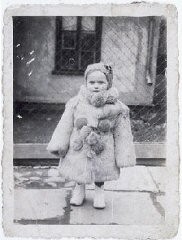
Gavra Mandil and his family narrowly escaped death in German-held Yugoslavia by fleeing to Italian-occupied Albania. There Gavra attended a school in Kavaja that had both Muslim and Christian pupils. He is seated on the far right in the first row. June 1943.
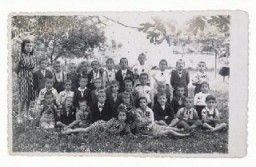
Jewish child Hans van den Broeke (born Hans Culp) in hiding in the Netherlands. He is 2 years old in this photograph.
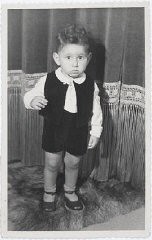
Some Jewish children survived the Holocaust because they were protected by people and institutions of other faiths. Children quickly learned to master the prayers and rituals of their "adopted" religion in order to keep their Jewish identity hidden from even their closest friends. This photograph shows two hidden Jewish children, Beatrix Westheimer and her cousin Henri Hurwitz, with Catholic priest Adelin Vaes, on the occasion of Beatrix's First Communion. Ottignies, Belgium, May 1943.
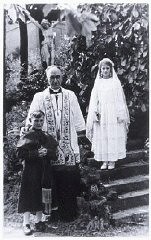
We would like to thank Crown Family Philanthropies, Abe and Ida Cooper Foundation, the Claims Conference, EVZ, and BMF for supporting the ongoing work to create content and resources for the Holocaust Encyclopedia. View the list of donor acknowledgement.